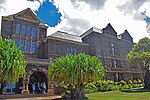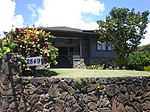Our Lady of the Mount Catholic Church (Honolulu)
Buildings and structures in HonoluluHawaii building and structure stubsHonolulu stubsRoman Catholic Diocese of HonoluluRoman Catholic churches in Hawaii ... and 2 more
United States Roman Catholic church stubsWestern United States church stubs

Our Lady of the Mount Catholic Church in Honolulu is a parish of the Roman Catholic Church of Hawaii in the United States. It falls under the jurisdiction of the Diocese of Honolulu and its bishop. Located in the Kalihi Valley neighborhood community, it once served the immigrant Portuguese pineapple and sugarcane plantation laborers of the early 20th century. They dedicated their church to Nossa Sanhora do Monte or Our Lady of the Mount, in honor of the Blessed Virgin Mary.
Excerpt from the Wikipedia article Our Lady of the Mount Catholic Church (Honolulu) (License: CC BY-SA 3.0, Authors, Images).Our Lady of the Mount Catholic Church (Honolulu)
Monte Street, Honolulu Kalihi Valley
Geographical coordinates (GPS) Address Nearby Places Show on map
Geographical coordinates (GPS)
| Latitude | Longitude |
|---|---|
| N 21.3458 ° | E -157.8608 ° |
Address
Monte Street 1636
96819 Honolulu, Kalihi Valley
Hawaii, United States
Open on Google Maps





